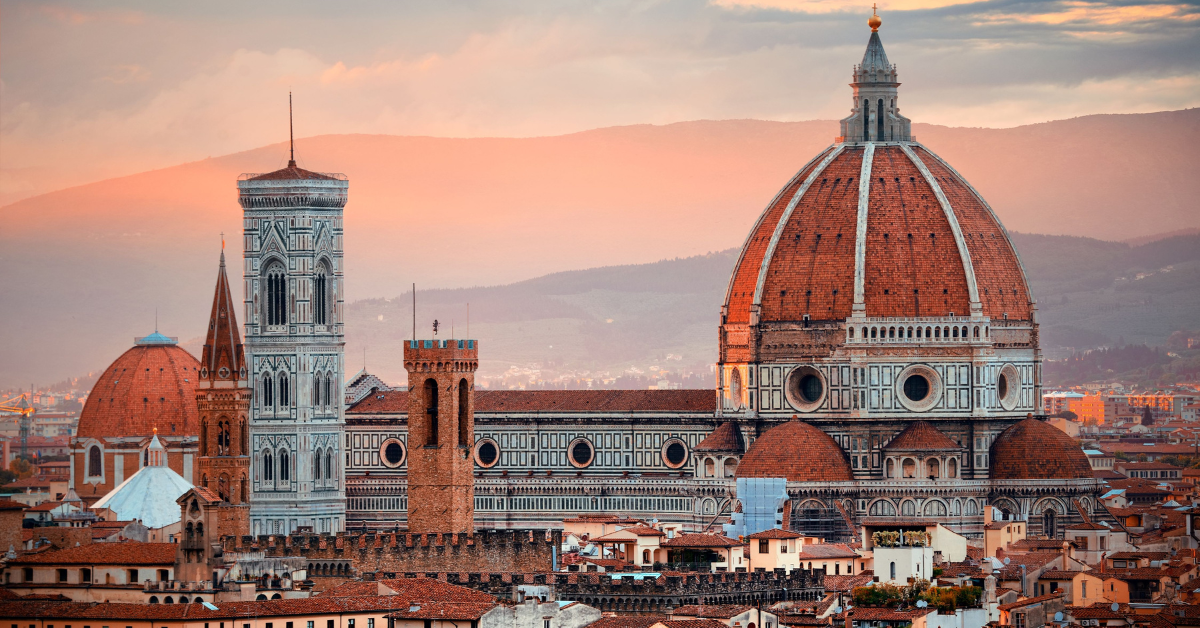Florence, known as “佛羅倫斯” in Japanese kanji, represents more than just a city’s name. It embodies the spirit of art, philosophy, and harmony that both Florence and Japan deeply cherish. This article explores how this unique transcription connects Renaissance ideals with Japanese aesthetics, showing why Florence continues to inspire admiration among Japanese people.
The Meaning of the Kanji “佛羅倫斯”
The kanji representation “佛羅倫斯 (Futsurarinsu)” emerged in Japan during the Meiji to Taishō periods as an attempt to phonetically transcribe Western place names. It is believed to have derived from the Chinese transcription “佛羅倫薩,” based on the Italian word “Firenze.”
| Kanji | Reading | Features |
|---|---|---|
| 佛羅倫斯 | Futsurarinsu | Most widely used and formal representation |
| 夫羅凌斯 | Furarinsu | Closer to the English pronunciation “Florence” |
| 福楞察 | Fukurensa | Rare, historical variant |
The character “佛” symbolizes spirituality, “倫” represents morality, and “斯” carries the nuance of the land’s resonance—altogether expressing a city of culture and idealism. In Japanese literature and geography books, this expression conveyed the exotic beauty and refinement of Western civilization. Even today, “佛羅倫斯” retains a poetic and historical resonance.
――――――――――――――――――――――
Geography and Cultural Background of Florence
Florence lies along the Arno River, surrounded by gentle Tuscan hills. Since the Middle Ages, it has flourished as a city where art, scholarship, and commerce harmoniously coexist. Under the patronage of the Medici family, Florence became the cradle of the Renaissance, influencing Europe and the world.
| Field | Representative | Achievement |
|---|---|---|
| Painting | Botticelli | The Birth of Venus |
| Sculpture | Michelangelo | David |
| Architecture | Brunelleschi | Cathedral of Santa Maria del Fiore |
Florence is not a museum frozen in time but a living city where art breathes through daily life. Every street corner and stone wall seems to carry centuries of creativity and craftsmanship.
――――――――――――――――――――――
Florence as a City of Sport
Beyond art, Florence is also a city of sports and passion. One of its most iconic traditions is the Calcio Storico, a form of football dating back to the 16th century. The game, which combines wrestling and soccer, symbolizes the pride and unity of Florentines.
| Category | Details |
|---|---|
| Name | Calcio Storico |
| Origin | Medici era, 16th century |
| Venue | Piazza Santa Croce |
| Feature | A mix of combat and football, played as a festival |
The event, held every June, is an explosion of energy—teams in historical costumes, drums echoing, and the crowd roaring. It represents the city’s living spirit just as much as its paintings and sculptures do.
In modern times, the professional football club ACF Fiorentina continues this legacy. Their purple (Viola) color represents the Tuscan sky and vineyards, becoming a symbol of regional pride.
| Club | Color | Characteristics |
|---|---|---|
| ACF Fiorentina | Purple (Viola) | Community-rooted, traditional club |
| Achievements | Serie A contender, European competition appearances | |
| Symbolic Spirit | Pride, passion, unity |
The stadium’s chants and songs have become a new form of Florence’s music, blending cultural pride with modern enthusiasm.
――――――――――――――――――――――
How Japanese People View Florence
To Japanese visitors, Florence is more than a destination—it is a place of beauty and dignity. Here, art and life intertwine; every bridge, lamp, and cobblestone embodies aesthetic care. This devotion to detail resonates deeply with Japanese craftsmanship and sensibility.
| Impression | Description |
|---|---|
| City of Art | Fusion of painting, architecture, and music |
| Historical Depth | The heart of Renaissance heritage |
| Sporting Passion | Calcio Storico and Fiorentina football culture |
| Civic Pride | Strong sense of tradition and identity |
Japanese travelers often describe Florence as “a city where even the air feels beautiful.” That feeling arises because art is not confined to museums—it lives in the rhythm of daily life. The city’s balance between artistic expression and athletic vigor reflects an ideal many Japanese admire.
――――――――――――――――――――――
The Fusion of Art and Sport
In Florence, art and sport are not opposites—they complement one another. The Calcio Storico parade features music, colorful costumes, and choreographed movements, blurring the line between athletic competition and performance art.
| Aspect | Art | Sport |
|---|---|---|
| Form of Expression | Painting, architecture, music | Body and spirit |
| Purpose | Pursuit of beauty and ideals | Expression of courage and pride |
| Common Traits | Passion, creativity, pride | Passion, creativity, pride |
Art refines the senses, and sport strengthens the soul. Together, they make Florence a city that is alive, expressive, and whole, where human potential is celebrated in every form.
――――――――――――――――――――――
Resonance with Japanese Culture
Florence and Japan share similar values—craftsmanship, harmony, and spirituality. Both cultures value process over perfection, cherishing the journey of creation more than its completion.
| Perspective | Florence | Japan |
|---|---|---|
| Essence of Beauty | Renaissance idealism | Wabi-sabi simplicity |
| Core Values | Individuality and creativity | Harmony and continuity |
| Spirit of Craft | Artist’s pride | Artisan’s sincerity |
| Traditional Events | Calcio Storico | Sumo, Matsuri festivals |
| Symbolic Spirit | Freedom and passion | Humility and balance |
These parallels help explain why Japanese people feel a deep emotional connection to Florence. The Florentine commitment to artistry, pride, and heart mirrors the Japanese concept of putting one’s soul into one’s work.
――――――――――――――――――――――
Conclusion
The kanji “佛羅倫斯” is more than a phonetic transcription—it is a symbol of art, passion, and human spirit. Florence represents the unity of Renaissance idealism and athletic vitality, harmonizing the past and the present, stillness and motion.
Florence teaches us what it means to live beautifully—to create, to strive, and to feel deeply. For the Japanese, “佛羅倫斯” embodies the aspiration to live with both elegance and strength, a timeless reflection of human potential and pride.






